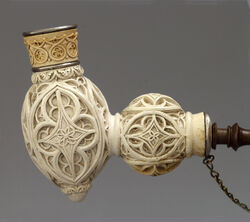Neo-Gothic at its best
January 2022

Surprisingly enough, the history of the cigar holder has not yet been properly recorded. While cigar smoking had already become known through Spain and Portugal from the end of the eighteenth century, the earliest surviving cigar pipes date from around 1850. In the first decades the smoker was so common to the pipe that for smoking the cigar a standard pipe model was used. The cigar stands upright in it. It is not until 1870 that the cigar will descend to an angle of 120 degrees with the stem. This meerschaum cheroot holder is therefore a fine example of the early form. The pipe itself has an oval shaped base for comfortable holding. The slightly conical holder for the cigar on top of it has an inner diameter of the standard cigar, because at that time people only smoked small cigars. This oval shape is repeated in meerschaum once more in the stem. The stem is made of turned wood with the usual knots, ending in a buffalo horn mouthpiece. The meerschaum is secured to the stem with a simple metal chain. The surface of the meerschaum is exuberant with neo-Gothic ornaments that provide a beautiful rhythm. The style is based on the English variant, the late Gothic perpendicular with an abundance of lines. This decoration, consisting of three- and four-passes, diamonds and braided bands goes up to four layers deep. Thanks to the case, we know that the seller at the time was a certain Peter Keiss, who had a shop on the chic Graben shopping street in Vienna. Whether he himself is the carver of this remarkable creation or merely the reseller we do not know. Many addresses in cases are those of the shopkeeper, the manufacture took place elsewhere. The dating of this pipe is quite unexpected. The Gothic Revival was popular for a short time, especially in the 1830s, and then quickly disappeared. Given the shape, we must really see in this pipe an early cigar holder, which is provided with a fashionable neo-Gothic decoration. Within a few years, this style is already obsolete, making this pipe a rarity.
Amsterdam Pipe Museum APM 24.337
Archive object of month